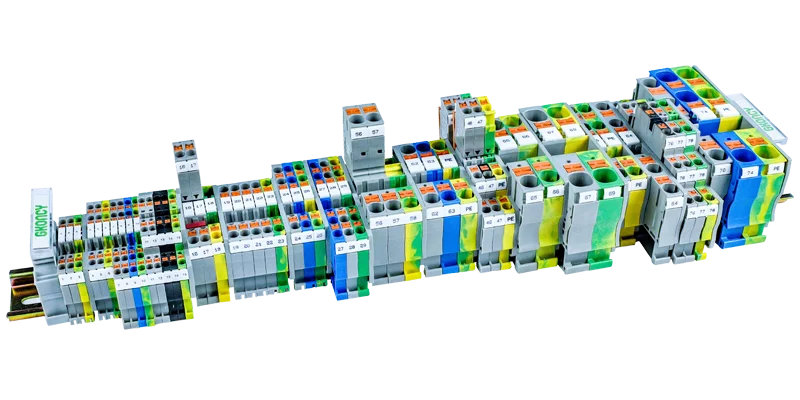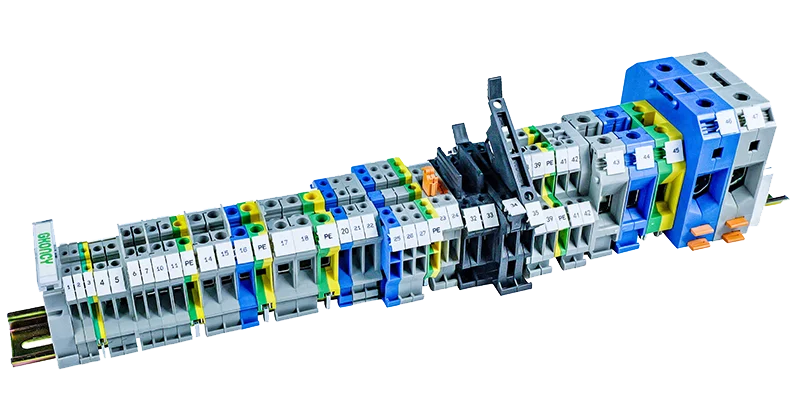Tabla de contenido
Hola, entusiasta de la electricidad. Si estás leyendo esto, es probable que estés inmerso en un proyecto que requiere la precisión y la confiabilidad de Bloques de terminales montados en riel DINPero con tantas opciones disponibles, ¿cómo saber qué bloque de terminales es el adecuado para sus necesidades? No tema, porque estoy aquí para guiarlo a través del proceso con un enfoque amigable. ¡Vamos a profundizar!
Calificación actual: El poder de tu conexión
Lo primero es lo primero: debes tener en cuenta la capacidad nominal de corriente del bloque de terminales. Esta es la cantidad máxima de corriente eléctrica que puede soportar de forma segura sin sobrecalentarse ni provocar un incendio. Es como saber cuánto peso puede soportar tu vieja y confiable mochila antes de que se estropee.
Verifique su carga: Observa los dispositivos que estás conectando. ¿Cuál es la corriente máxima que consumen? Tu bloque de terminales debería soportar esto sin problemas.
Margen de seguridad: Siempre es una buena idea elegir un bloque de terminales con una clasificación de corriente más alta que su carga máxima para garantizar la seguridad y la longevidad.

Voltaje nominal: La chispa de la vida
La tensión nominal es otro factor crítico. Indica la tensión máxima que puede soportar el bloque de terminales. Piense en ello como el “límite de velocidad” de la tensión para su bloque de terminales.
Adapte su sistema: Asegúrese de que el voltaje nominal sea compatible con el voltaje de su sistema eléctrico. Superar este límite puede provocar daños o incluso situaciones peligrosas.
Compatibilidad de tamaños de cables: el arte de la adaptación
La compatibilidad del tamaño de los cables es como encontrar el par de zapatos perfecto para tus pies (o en este caso, para tus cables). Quieres un calce ceñido, ni demasiado apretado ni demasiado suelto.
Consulte las especificaciones: Los bloques de terminales están diseñados para tamaños de cables específicos. Consulte las especificaciones del fabricante para asegurarse de que sus cables encajen.
Calibre del cable: Los tamaños de cable más comunes varían de 14 AWG (grueso) a 26 AWG (fino). Elija un bloque de terminales que coincida con el calibre de su cable.

Material de aislamiento: El protector
El aislamiento es lo que mantiene los cables a salvo de cortocircuitos y otros problemas eléctricos. Es como un escudo para las conexiones eléctricas.
Asuntos materiales: Los materiales más comunes incluyen el PVC, que es rentable, y el termoplástico, que ofrece una mejor resistencia al calor. Elija en función de la temperatura y la exposición química de su aplicación.
Codificación de colores: Algunos bloques de terminales vienen con aislamiento codificado por colores para una fácil identificación. ¡Un buen detalle para los fanáticos de la organización!
Condiciones ambientales: la prueba del tiempo
Su bloque de terminales se enfrentará a todo tipo de desafíos ambientales. Es como un soldado en el campo de batalla de su instalación eléctrica.
Temperatura: Desde veranos abrasadores hasta inviernos gélidos, su bloque de terminales debe poder soportar los cambios bruscos de temperatura.
Humedad: Si su instalación se realiza en un entorno húmedo, busque bloques de terminales con alta resistencia a la humedad.
Resistencia a la corrosión: Para aplicaciones industriales, elija bloques de terminales que puedan soportar productos químicos agresivos y entornos corrosivos.

Facilidad de instalación: el toque fácil de usar
Por último, pero no menos importante, considere lo fácil que es instalar el bloque de terminales.
Compatibilidad con riel DIN: asegúrese de que se adapte a su sistema de riel DIN sin problemas.
Tornillos o pulsadores: algunos bloques de terminales utilizan tornillos para conexiones seguras, mientras que otros utilizan pulsadores para una instalación rápida. Elija lo que mejor se adapte a su flujo de trabajo.
Concluyendo: La lista de verificación
Antes de salir a elegir su bloque de terminales, aquí tiene una lista de verificación rápida que debe tener en el bolsillo:
Clasificaciones de corriente y voltaje: adáptelas a su sistema.
Tamaño del cable: garantizar la compatibilidad.
Material de aislamiento: elija uno que se adapte a su entorno.
Resistencia ambiental: ¿Puede soportar las condiciones?
Facilidad de instalación: Debería ser muy sencilla.
Elegir lo correcto Bloque de terminales montado en riel DIN Se trata de comprender sus necesidades y combinarlas con el producto adecuado. Con esta guía, ahora está preparado para tomar una decisión informada. ¡Siga adelante y conquiste sus proyectos eléctricos con confianza!
